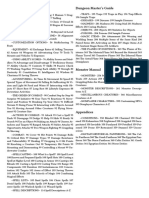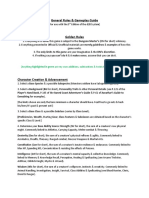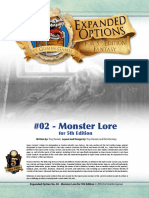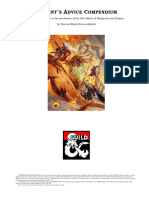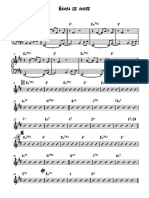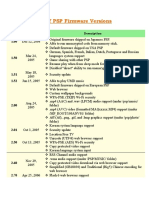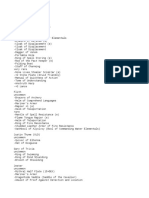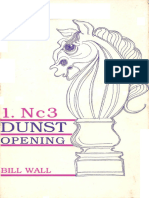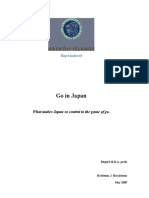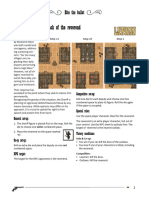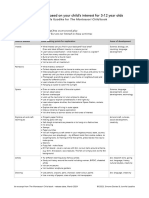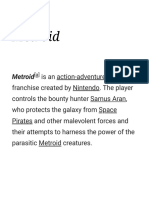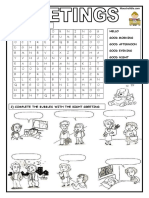INTRODUCTION
Welcome to Pathfinder NPC Core! Here you’ll nd Attribute Modiers The creature’s attributes are listed here.
hundreds of characters to populate your towns, castles, Items Any signicant gear the creature carries is listed here.
guildhouses, slums, caravans, and even the wilds beyond. Interaction Abilities Special abilities that aect how a creature
To use this book, you’ll need the rules and guidance of perceives and interacts with the world are listed here.
Pathfinder Player Core and Pathfinder GM Core. AC, followed by any special bonuses to AC; Saving Throws A
Each section of this book includes a group of related special bonus to a specic save appears in parentheses after
creatures, presenting their game statistics, illustrating their that save’s bonus. Any bonuses to all three saving throws
place within the game world, and providing details about are listed after the three saves.
their behavior or society. Chapter 1 includes broadly useful HP, followed by automatic abilities that aect the creature’s
human NPCs, Chapter 2 covers a few iconic NPCs for non- Hit Points or healing; Immunities; Weaknesses; Resistances
human ancestries, and the appendix contains numerous Any immunities, weaknesses, or resistances are listed here.
tools, from pets to spell lists to a relationship subsystem. Automatic Abilities The creature’s auras, any abilities that
automatically aect its defenses, and the like are listed here.
Playing Creatures Reactive Abilities Free actions or reactions that are usually
This section provides the basics for using the creatures in triggered when it’s not the creature’s turn are listed here.
this book. It guides you through the process of reading Speed, followed by any other Speeds or movement abilities.
and understanding creature statistics so you know how Melee The name of the weapon or unarmed attack
to present a creature as a threat or ally in and out of the creature uses for a melee Strike, followed by the
combat, and notes how to adjust creatures to the needs attack modier and traits in parentheses (some weapon
of your game. traits, such as deadly, include their calculations for
convenience). If a creature has any abilities or gear that
Reading Creature Statistics would aect its attack modier, such as a weapon with a
Each creature’s rules appear in a stat block, with a structure +1 weapon potency rune, those calculations are already
similar to those of feats, spells, and magic items. Because included, Damage amount and damage type, plus any
creatures have more abilities than those game elements, additional eects (this entry is Eect if the Strike doesn’t
however, their statistics include more entries, many of deal damage).
which have special formatting. Ranged As Melee, but also lists range or range increment
A creature’s traits line sometimes begins with a rarity; if the with traits, Damage as Melee.
creature’s rarity is common, no rarity is listed. The next entry Spells The entry starts with the magical tradition and whether
is the creature’s size (Tiny, Small, Medium, Large, Huge, or the spells are prepared or spontaneous, followed by the DC
Gargantuan). Any other traits are then listed alphabetically. (and spell attack modier if any spells require spell attack
Actions and activities the creature can use have the rolls). Spells are listed by rank, followed by cantrips. A
appropriate icons next to those abilities’ names noting spell prepared multiple times lists the number of times in
how many actions they require. A creature always has the parentheses—for example, “(×2).” Spontaneous spells list the
requisite prociency ranks or other abilities required to use number of spell slots after the spell rank.
what’s listed in its stat block. For instance, a spellcasting Innate Spells These are listed like other spells, but can also
creature can perform the Cast a Spell activity, and a include constant, at-will, and focus spells. Spells that can be
creature is never untrained with any of its items. used an unlimited number of times list “(at will)” after the
Some abilities are abbreviated in stat blocks, with their spell’s name. Constant spells appear at the end, separated by
full text in the Ability Glossary on pages 230–231. rank. Rules for constant and at-will spells appear on page 230
in the Ability Glossary.
CREATURE NAME CREATURE (LEVEL) Focus Spells If a creature has focus spells, this entry lists the
RARITY SIZE OTHER TRAITS spells, the spells’ rank, the Focus Points in the creature’s
Perception The creature’s Perception modier is listed here, focus pool, and the DC.
followed by any special senses. Rituals Any rituals the creature can cast appear here. The
Languages The languages for a typical creature of that kind are creature can choose to automatically succeed without rolling
listed here, followed by any special communication abilities. on any of these rituals or can roll normally.
If a creature lacks this entry, it can’t communicate with or Oensive or Proactive Abilities Any actions, activities, or
understand another creature through language. abilities that automatically aect the creature’s oense, as
Skills The creature is trained or better in these skills. For well as free actions or reactions that are usually triggered on
untrained skills, use the corresponding attribute modier. the creature’s turn, appear here in alphabetical order.
4
� Introduction
Introduction
Adjusting Creatures • Decrease the creature’s level by 1; if the creature is
This section guides you through some basic strategies you level 1, instead decrease its level by 2. NPC Gallery
can use to adjust an NPC’s power level and specics. • Decrease the creature’s AC, attack modiers, DCs, Ancestry NPCs
saving throws, Perception, and skill modiers by 2.
Appendix
Combat Power • Decrease the damage of its Strikes and other offensive
In many cases, you can make relatively minor adjustments abilities by 2. If the creature has limits on how many Glossary & Index
to a creature’s statistics, called elite and weak adjustments, times or how often it can use an ability (such as a
to raise or lower its level by 1. Elite and weak adjustments spellcaster’s spells or a dragon’s breath), decrease the
work best with creatures that focus on physical combat. damage by 4 instead.
These adjustments overstate the normal numerical gains • Decrease the creature’s HP based on its starting level.
the creature would make from increasing its level to make
up for the lack of new special abilities. Creatures that cast Starting Level HP Decrease
spells or rely on noncombat abilities typically need specic 1–2 –10
adjustments. Applying the elite or weak more than once to 3–5 –15
a creature should be avoided. For major changes, see the 6–20 –20
Pathfinder GM Core guidance on building creatures. 21+ –30
SPECIALIST LEVELS Languages
The level on an NPC’s stat block is their level for a You can freely add or remove languages from stat blocks!
combat encounter. But many of these NPCs are primarily The main languages are listed on page 89 of Player Core.
noncombatants much more skilled in their occupation than
in combat. Specialist NPCs’ stat blocks include an entry Gear
noting that they have a higher level when the PCs have to Most NPCs rely on gear, like armor and weapons. If an
compete against them in their area of expertise. NPC loses a crucial piece of gear, follow the advice on
page 7 of Monster Core.
Elite Adjustments Skills, Perception, and Prociency
Sometimes you’ll want a creature that’s just a bit more If you need to know the creature’s prociency rank,
powerful than normal so that you can present a challenge creatures are trained in the skills listed in their stat blocks
that would otherwise be trivial or show that one enemy is and untrained in the rest. Prociency in listed skills usually
stronger than its kin. To do this quickly and easily, apply upgrades to expert around 5th level, master around 9th
the elite adjustments to its statistics as follows: level, and legendary around 17th level. Many creatures
• Increase the creature’s level by 1; if the creature is level start with expert prociency in Perception and improve
–1 or 0, instead increase its level by 2. to master prociency around 7th level and legendary
• Increase the creature’s AC, attack modiers, DCs, prociency around 13th level. You might grant a creature
saving throws, Perception, and skill modiers by 2. with world-class aptitude for a particular skill or Perception
• Increase the damage of its Strikes and other offensive a higher prociency rank.
abilities by 2. If the creature has limits on how many
times or how often it can use an ability (such as a Sidebar Icons
spellcaster’s spells or a dragon’s breath), increase the Each sidebar in a creature section is marked with an icon
damage by 4 instead. identifying the type of information it contains.
• Increase the creature’s Hit Points based on its starting
level (see table below). Additional Lore
Starting Level HP Increase
1 or lower 10 Advice and Rules
2–4 15
5–19 20
20+ 30 Locations
Weak Adjustments
Sometimes you’ll want a creature that’s weaker than Related Creatures
normal so you can use a creature that would otherwise
be too challenging or show that one enemy is weaker
than its kin. To do this quickly and easily, apply the weak Treasure and Rewards
adjustments to its statistics as follows.









